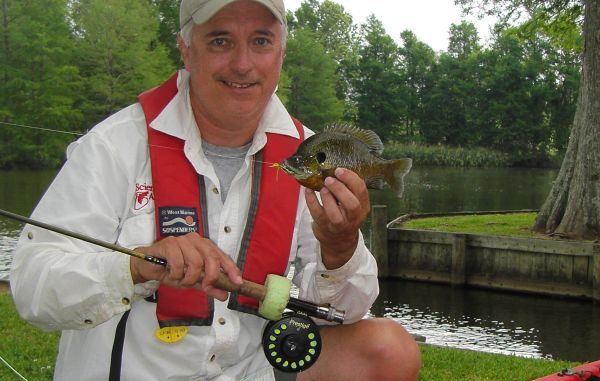
Get down with Old River Gobbules
Look at a map of eastern Louisiana, from Bastrop to New Roads, and you’ll realize the power of the mighty Mississippi. Over millennia, the great river has carved out dozens of deep waterways, most of which have become isolated from the river’s flow.
These oxbow lakes offer some of the best fly fishing for bluegill and redears anywhere in the country.
Take False River near New Roads, for instance. At one time, this was the crown jewel of bream fishing in America. From March to October, it was pretty much a sure thing to catch 30 to 50 keeper-sized bream on the fly in just a half day on the water.
Sad to say, False River ain’t what it used to be — the victim of a combination of environmental factors, including runoff of herbicides that killed off the grass that made the lake so productive.
The good news is that steps are being taken to revive the lake to its former glory.
Fortunately, False River is just one of many. Other oxbows include Old River Morganza, Deer Park Lake, Old River Vidalia, and Lakes Yucatan, Bruin, Joseph, Cocodrie Lake, Black River and Tew — the list goes on and on.
And at times, most of these can be as productive as False River once was.
When fly fishing oxbow lakes, there are three tactics that work best.
The first tactic is to fish the shallows at the ends of the lake using popping bugs. On oxbows, this is an early morning or late-evening strategy that works well.
If there’s little boat traffic that day, I also find popping bugs work great in the afternoons around docks and shorelines.
The second tactic is a lot more consistent on oxbows: Place a weighted fly about 2 to 3 feet under a small strike indicator, and cast away from the bank just inside the drop-off. These are the areas where bluegill stage for bedding.
Cast the fly out, then let it sink down. Then twitch the float an inch or so, then pause for three seconds. Continue this process a few times, then recast to a new spot. Often the strike is delicate: Even big stumpknockers will make the float twitch rather than sink it down. Just be patient and keep working it.
The third tactic is deep jigging. If you use a floating fly line, then you want a long, light leader.
For most bream fishing, a 6- or 7-foot leader is helpful for short casts and to cast under trees. However, for deep jigging, you’re looking at a 9-foot leader.
Realize that a 9-foot leader doesn’t get the fly 9 feet down. The heavier butt section of the leader slows the sink rate such that it’s more of an arc between the fly and fly line. Using a light butt material, about 14 pounds, and light tippet, about 8 pounds, helps get the fly deeper.
In addition, you want a weighted fly. For this method, I use Fluff Butts tied on a 1/80- or 1/100-ounce jighead, or tied using a tungsten beadhead on conventional streamer hook.
The deep jigging technique calls for counting the fly down until it hits bottom (the leader stops sinking) or you reach the count of 10. Then you strip ever so slightly, pausing one second between strips. This tactic is possibly the best I’ve ever used for catching chinquapin, a.k.a., redears or shellcrackers, at Lakes Bruin and St. John.
Anytime you fish an oxbow lake using weighted flies, you run the risk of hooking into catfish (big ones, too), stripers, hybrid stripers, bass and freshwater drum. In fact, two of the fly rod world record drum, a.k.a, gaspergoo, were caught in Louisiana oxbows — by me.
For that reason, it’s important to make certain you use quality leader material and tie the proper knots. Most trout leaders call for blood knots because of their small profile. But for warmwater fishing, profile isn’t important. Strength is. For that reason, use a surgeon’s knot or a Uni-knot to construct your leaders.
The standard de facto tackle for fishing panfish of all species is a 5-weight rod with matching weight-forward floating line. This rod will handle catfish up to 15 pounds, and big bass, yet light enough for a half-pound bluegill to give a good bend.
If you want to have some real fun, bring along a 3-weight rod. Just beware those stripers and cats have no respect for ultralight tackle!
Overall, the 8-foot, 5-weight has been my go-to rod for bream fishing. Short enough to work under trees, long enough to easily shoot line when needed.
With a few exceptions, most oxbow lakes are ideal for paddling — fishing from a canoe or kayak. An oxbow of the Red River, Cane River Lake is one of my favorites for kayak fishing. It’s 30 miles long, but less than a football field wide. And with so many twists and turns, there’s always several lee spots to fish on breezy days.


